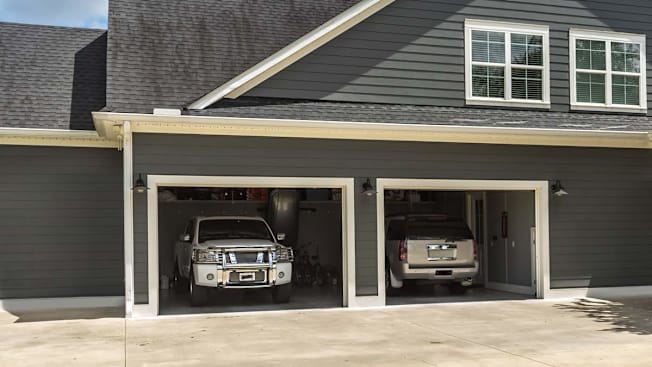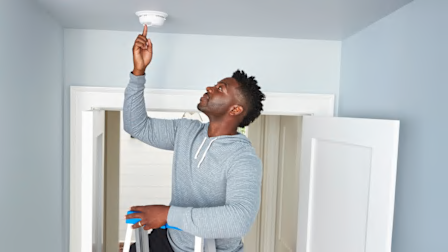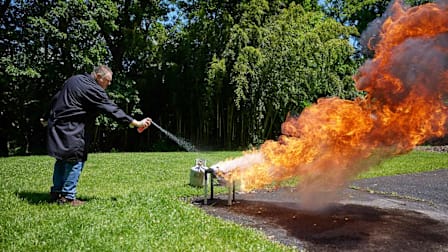Your Garage Needs a Heat-Sensing Fire Alarm
Why a smoke detector may not be enough to protect you and your family

Having a fire alarm in your garage is important, especially if your home has an attached garage or a garage near rooms where people sleep.
Fires can spread quickly, and by the time a garage fire starts to consume a home, it poses a serious threat to both life and property. But a typical smoke alarm won’t work well enough for your garage. You need a heat detector.
Types of Fire Alarms
The NFPA says that there should be smoke alarms on every floor of a residence—both inside and outside sleeping rooms, and at both ends of hallways longer than 40 feet. (Note: Your home should also have a fire extinguisher on every floor, as well as in kitchens and garages.) Newer homes and homes that have been renovated now have hardwired, interconnected alarm systems that will set off all the alarm modules if one of them detects smoke or carbon monoxide. These are often part of comprehensive home security systems. For older homes that don’t have special fire alarm wiring, Bluetooth-enabled alarms are available to perform this function wirelessly. And many new alarms feature apps that will notify your phone if an alarm is activated.
Which kind of alarm do you need? It depends on where you’re putting it. Read on to learn more about the various types.
Smoke Detectors
These can be hardwired, battery-operated, or powered by electricity from an outlet (with a battery backup in case of a power failure). Some battery-operated units come with lithium batteries that last up to 10 years, while others contain traditional AAA, AA, and 9-volt batteries that should be checked or replaced annually.
According to NFPA, most fire deaths are caused by inhalation of smoke, which usually contains the toxic combustion byproducts from burning plastics, foams, and other common synthetic household materials.
Because smoke rises with heat, smoke detectors should be placed near the ceiling to ensure early detection. The best place to put smoke detectors is in sleeping rooms, hallways, and near the kitchen (at least 10 feet from the stove, where cooking can cause constant false alarms). Check Consumer Reports’ ratings of the best smoke detectors.
What to Do If Your Car Catches Fire
CR shares these steps to prevent a car fire and, if necessary, deal with a fire.
Carbon Monoxide Detectors
Carbon monoxide is an odorless, colorless gas that is slightly lighter than room air, meaning it tends to rise. It can accumulate in indoor spaces if there’s a gas leak, or if a furnace, boiler, or water heater is malfunctioning. According to the Centers for Disease Control and Prevention, more than 400 Americans die from accidental CO poisoning every year and more than 100,000 require emergency care.
Like smoke detectors, CO alarms come in hardwired, battery-operated, or plug-in varieties. NFPA recommends installing CO detectors on every level of your home, outside sleeping areas, and outside attached garages, where a car may have been inadvertently left running. (Note: Driving the car in and out of an attached garage on a regular basis should not set off CO alarms mounted inside the house. But this is protection against a car being left running in a closed garage.) Look over CR’s reviews and ratings for the best CO detectors. CR also tests combination smoke/CO alarms.
Heat Detectors
These devices work where smoke detectors can be problematic, such as areas where dust, humidity, and steam are often present. This is why you don’t often see smoke detectors in bathrooms. Heat detectors do exactly what the name implies: They sound an alarm when a high temperature indicates that a fire has started, either at a set temperature threshold, or when the temperature rises quickly enough to indicate that a fire has started. They’re ideal in garages, where dust, humidity, car exhaust fumes, and even insects can cause false alarms in a smoke detector.
The U.S. Fire Administration advises installing a garage heat alarm that’s interconnected with the other fire alarms in your home, with a temperature rating between 175° F and 200° F. (The temperature inside an unconditioned garage can exceed 100° F in summer, but sunlight alone won’t cause the temperature to rise enough to trigger the alarm.) The agency also advises mounting these devices away from fluorescent lights, which can impact their operation.
A number of models are available, including both standalone units and interconnected models that work through a smartphone app with a wireless base station. (CR hasn’t tested heat detectors.)
Interconnected heat alarms are your best option, as they will set off other smoke and CO alarms in your house if there’s a fire in the garage, giving you more time to call 911 and get to safety.
There are also hardwired heat detectors (equipped with battery backup) that are usually installed in newer construction and renovations, but they may be more difficult to install in an existing structure.
More on Car Insurance
• CR’s Car Insurance Ratings and Buying Guide
• Best Car Insurance Companies
• Cheapest Car Insurance Companies
• How to Lower Your Car Insurance Rates
• Best Car Insurance Companies for Seniors
• Everything You Need to Know About Teen Car Insurance
• Proven Ways to Save on Car Insurance Even If You’re a Safe Driver
• How to Keep Your Car From Getting Stolen
• How to Prevent Catalytic Converter Theft




















